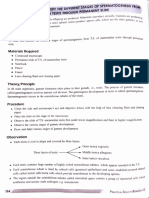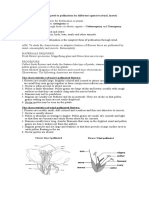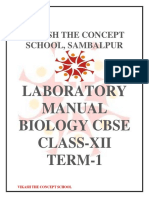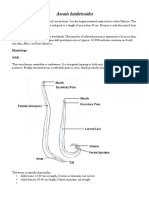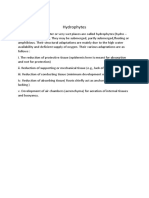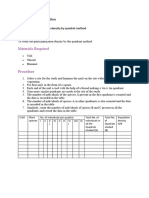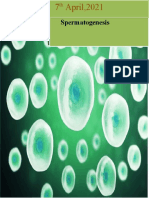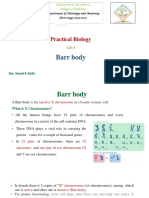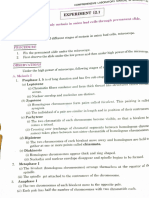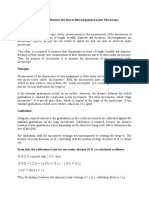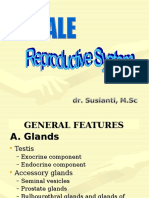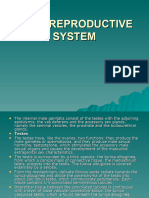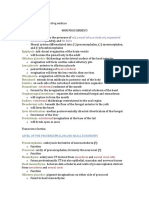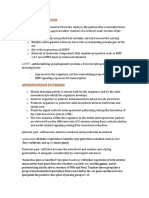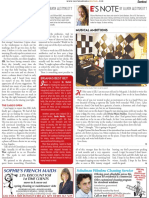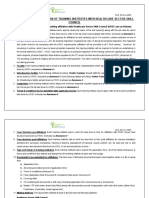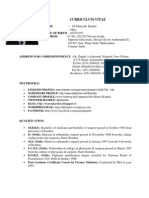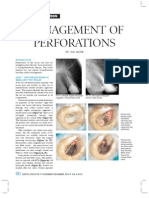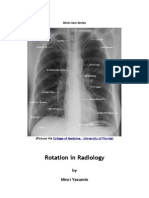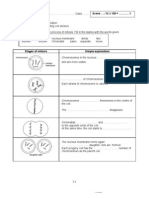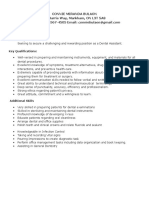Spermatogenesis
Occurs in seminiferous tubules
Cysts are separated from each other by septa (composed of connective
tissues); grasshopper only
Spermiogenesis
Most of the cytoplasm sloughed off except for a small amount which becomes
the tail sheath
Chromatin mass becomes the head
Definitive sperm is composed of – head, middle piece (centrosome,
mitochondria), tail
GRASSHOPPER TESTIS
Spermatogonia- 2n
blunt end of testis
beaded appearance of chromatin
large nuclei
-----GROWTH------
Primary Spermatocytes- 2n
Interphase- single pale vascular nucleolus
Leptotene- filamentous chromatin; most uncoiled (longest) state of
chromosomes; cell appear completely filled
Zygotene (Synaptene)- beginning of pairing (synapsis) of homologous
chromosomes in synaptonemal complex; bouquet configuration
Pachytene- thicker chromosomes; crossing over
Diplotene- chromosomes partly split; Chiasma first seen here; Configurations
include X, cross, loop
Diakinesis- Configurations incluse loop, ring, cross, bar
Secondary Spermatocytes- n
Smaller than primaries
Spermatids- n
half the size of secondaries
undergo spermiogenesis
Spermatozoa- n
proximal region of the testis
FROG TESTIS
Mesorchium
All except grasshopper
What type of tissue
Tunica albuginea
Outer connective tissue
Aka intertubular connective tissue or septula
Covers each seminiferous tubule
Seminiferous tubule
� Contain spermatogenic cells and Sertoli cells or nurse cells (columnar
cells)
Connected to vas deferns
Differs to cysts such that the cells may be undergoing all stages of maturation
May contain cysts in different stages of maturation
Spermatocyst
Aka cell nest or follicular cyst
Similar to grasshopper cyst
Spermatogenic cells surrounded by follicle cells
primary spermatogonium+follicle cells = spermatocyst
Sertoli cells
associated with primary spermatogonia and spermatocytes as follicle cells
Mesonephric tubules- where sperm are stored for a short time after detachment
from testis
Ovotestis- egg cells between seminiferous tubules
Spermatogonia- 2n
residual spermatozoid- source of germ cell proliferation
daughter cells from spermatogonial divisions retain follicle cells
Primary spermatocytes- 2n
large irregularly spherical cells
can be seen using LPO
Secondary spermatocytes- n
half the size of primaries
lie toward the lumen of the tubule
Spermatids- n
one centriole passes into the nucleus
other centriole gives rise to flagellum
Spermatozoa- n
length- 0.30 mm
acrosome found in the head (help the sperm get through the egg's protective
coat and to allow the plasma membranes of the sperm and egg to fuse)
group into 25-40 cells during maturation
MOUSE TESTIS
Tunica albuginea
tissue that cover the organ
fibrous connective tissue with mesothelial cells (provide a slippery, non-
adhesive and protective surface.)
Seminiferous tubules
made of seminiferous epithelium (with 2 types of cells: Sertoli cells
(somatic) and male sex cells
with: small blood vessels filled with erythorocytes
clumps of cells with conspicuous nuclei (Leydig cells)
connective tissue cells with spindle-shaped nuclei (follicle cells ata)
Sertoli cells
� spaced at regular intervals against the basement membrane
Functions: (1) form the blood-testes barrier (2) determine which substance
reach the germ cells (3) produce antigen-binding proteins necessary for
spermiogenesis
Types: Active- fulfilling its normal function; pyramidal in shape; apex
towards the lumen
Inactive- polygonal in shape
Spermatogonia- 2n
Rests on basement membrane
Gonial layer- thin with deeply staining cells
Small nuclei compared to spermatids
Types: A- germ cell line
B- most common gonia; last stage before they transform into PS
Intermediate- nuclei in the center
Primary spermatocytes- 2n
Nuclear envelope no longer visible
Interphase- similar to gonial B in appearance: 3% of the total spermatogenic
cycle (6 hours)
Metaphase- 20 tetrads are visble
Anaphase- (late) show cleave furrow
Telophase- 2 groups of dyads are formed aggregates at the poles
Secondary spermatocytes- n
Spermatids- n
Nucleus decrease in size due to elimination of nuclear sap
(early) red granule near the nucleus is the golgi apparatus or its product,
acrosomal rudiment
Spermatozoa
innermost layer of the tubule
�SPERMATOGENESIS SUMMARY
Grasshopper Frog (Rana Mouse (Mus musculus) Chick
(ewan q) sp.) (Gallus
gallus
domesticus
)
Unique Lobes, Spermatocyst Sertoli cells *same with
stages/parts Cysts, s, Active- mouse
Leptotene, Ovotestis pyramidal
Zygotene Inactive-
(synaptene), polygonal
Pachytene, Spermatogonia
Diplotene, Type A- light,
Diakinesis granular
Type B- dark
Intermediate-
dark border
Staining Feulgen Hematoxylin – for
methods method (for nuclei
DNA) Eosin- for acidic
Cytoplasm components of the cell
stained including cytoplams
yellow or
brown
Additional Leydig cells- Spermatogenic
info produce cycles lasts for
(possible testosterone 48 days
side Successive
questions) cycle starts
every 12 days
4 overlapping
cycles at every
site along the
tubule
spermatogonia
are outside the
blood-testes
barrier
Spermatogenic
cycle does not
take place
simultaneously
in all tubules
� Translocation
of
spermatogonia
by sertoli cells



